Gender and Education: Examining Social Constructs and Outcomes
VerifiedAdded on 2023/01/16
|7
|1940
|31
Essay
AI Summary
This essay delves into the intricate relationship between gender and education, exploring how societal constructs and stereotypes influence educational experiences and outcomes. The paper highlights the pervasive nature of gender lore and its impact on institutions, desires, and beliefs, leading to issues like illiteracy and unemployment among girls. It examines how gendered expectations in schools, such as differences in physical activity and aggression, contribute to unequal treatment. The essay discusses gender stereotyping, its impact on academic performance, and the persistence of inequalities despite feminist reforms. It also addresses the gender divide in responsibilities and performance, analyzing the role of globalization and individualization in shaping gendered experiences. Furthermore, the essay emphasizes the importance of gender equality for UNESCO's Sustainable Development Goals, addressing issues like bullying, sexual harassment, and violence, and their consequences on students, including absenteeism, low grades, and dropouts. The essay concludes by emphasizing the need to address gender inequalities and promote equitable educational opportunities for all.

Running head: GENDER AND EDUCATION
Gender and Education
Name of the Student
Name of the University
Author Note
Gender and Education
Name of the Student
Name of the University
Author Note
Paraphrase This Document
Need a fresh take? Get an instant paraphrase of this document with our AI Paraphraser
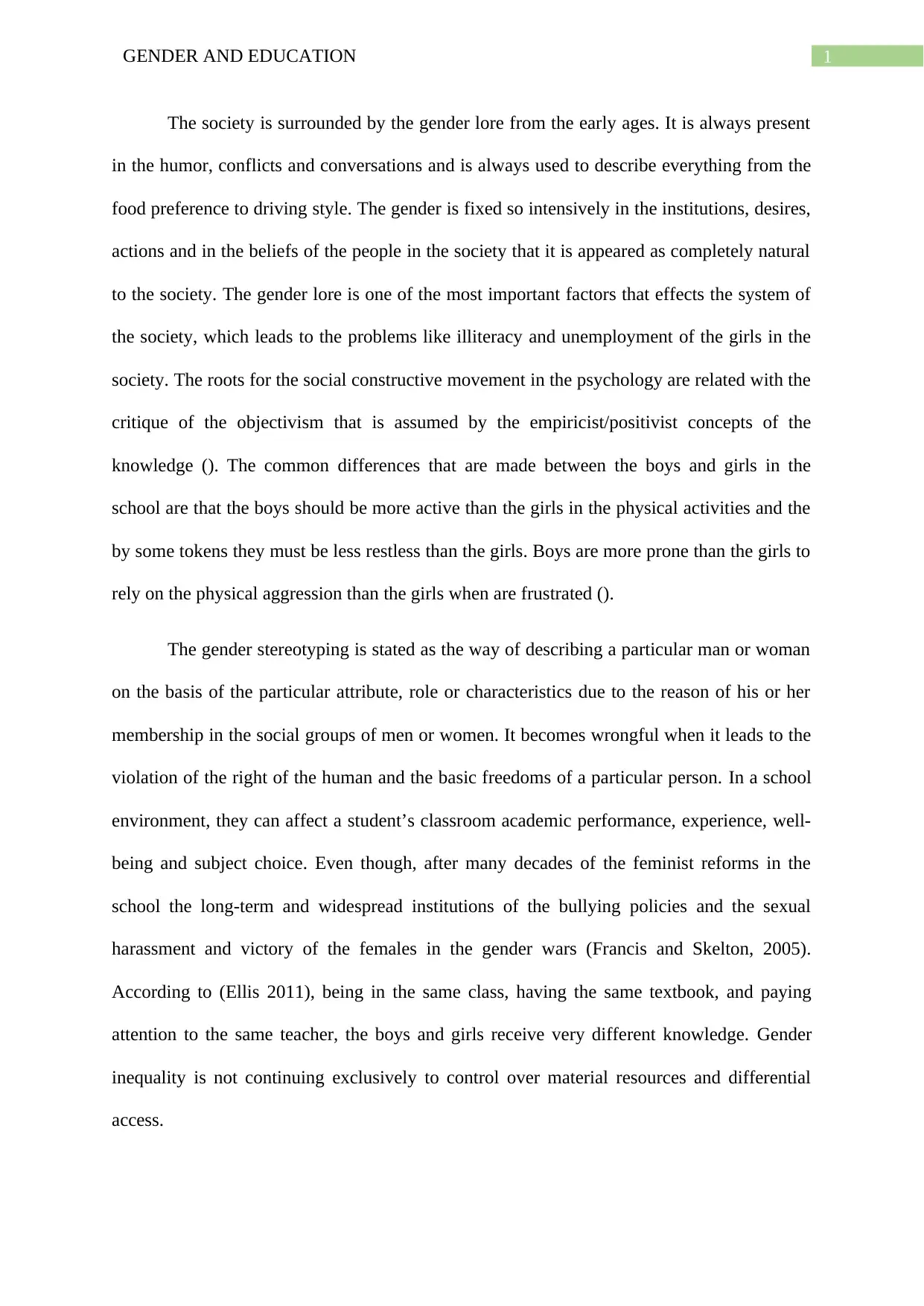
1GENDER AND EDUCATION
The society is surrounded by the gender lore from the early ages. It is always present
in the humor, conflicts and conversations and is always used to describe everything from the
food preference to driving style. The gender is fixed so intensively in the institutions, desires,
actions and in the beliefs of the people in the society that it is appeared as completely natural
to the society. The gender lore is one of the most important factors that effects the system of
the society, which leads to the problems like illiteracy and unemployment of the girls in the
society. The roots for the social constructive movement in the psychology are related with the
critique of the objectivism that is assumed by the empiricist/positivist concepts of the
knowledge (). The common differences that are made between the boys and girls in the
school are that the boys should be more active than the girls in the physical activities and the
by some tokens they must be less restless than the girls. Boys are more prone than the girls to
rely on the physical aggression than the girls when are frustrated ().
The gender stereotyping is stated as the way of describing a particular man or woman
on the basis of the particular attribute, role or characteristics due to the reason of his or her
membership in the social groups of men or women. It becomes wrongful when it leads to the
violation of the right of the human and the basic freedoms of a particular person. In a school
environment, they can affect a student’s classroom academic performance, experience, well-
being and subject choice. Even though, after many decades of the feminist reforms in the
school the long-term and widespread institutions of the bullying policies and the sexual
harassment and victory of the females in the gender wars (Francis and Skelton, 2005).
According to (Ellis 2011), being in the same class, having the same textbook, and paying
attention to the same teacher, the boys and girls receive very different knowledge. Gender
inequality is not continuing exclusively to control over material resources and differential
access.
The society is surrounded by the gender lore from the early ages. It is always present
in the humor, conflicts and conversations and is always used to describe everything from the
food preference to driving style. The gender is fixed so intensively in the institutions, desires,
actions and in the beliefs of the people in the society that it is appeared as completely natural
to the society. The gender lore is one of the most important factors that effects the system of
the society, which leads to the problems like illiteracy and unemployment of the girls in the
society. The roots for the social constructive movement in the psychology are related with the
critique of the objectivism that is assumed by the empiricist/positivist concepts of the
knowledge (). The common differences that are made between the boys and girls in the
school are that the boys should be more active than the girls in the physical activities and the
by some tokens they must be less restless than the girls. Boys are more prone than the girls to
rely on the physical aggression than the girls when are frustrated ().
The gender stereotyping is stated as the way of describing a particular man or woman
on the basis of the particular attribute, role or characteristics due to the reason of his or her
membership in the social groups of men or women. It becomes wrongful when it leads to the
violation of the right of the human and the basic freedoms of a particular person. In a school
environment, they can affect a student’s classroom academic performance, experience, well-
being and subject choice. Even though, after many decades of the feminist reforms in the
school the long-term and widespread institutions of the bullying policies and the sexual
harassment and victory of the females in the gender wars (Francis and Skelton, 2005).
According to (Ellis 2011), being in the same class, having the same textbook, and paying
attention to the same teacher, the boys and girls receive very different knowledge. Gender
inequality is not continuing exclusively to control over material resources and differential
access.
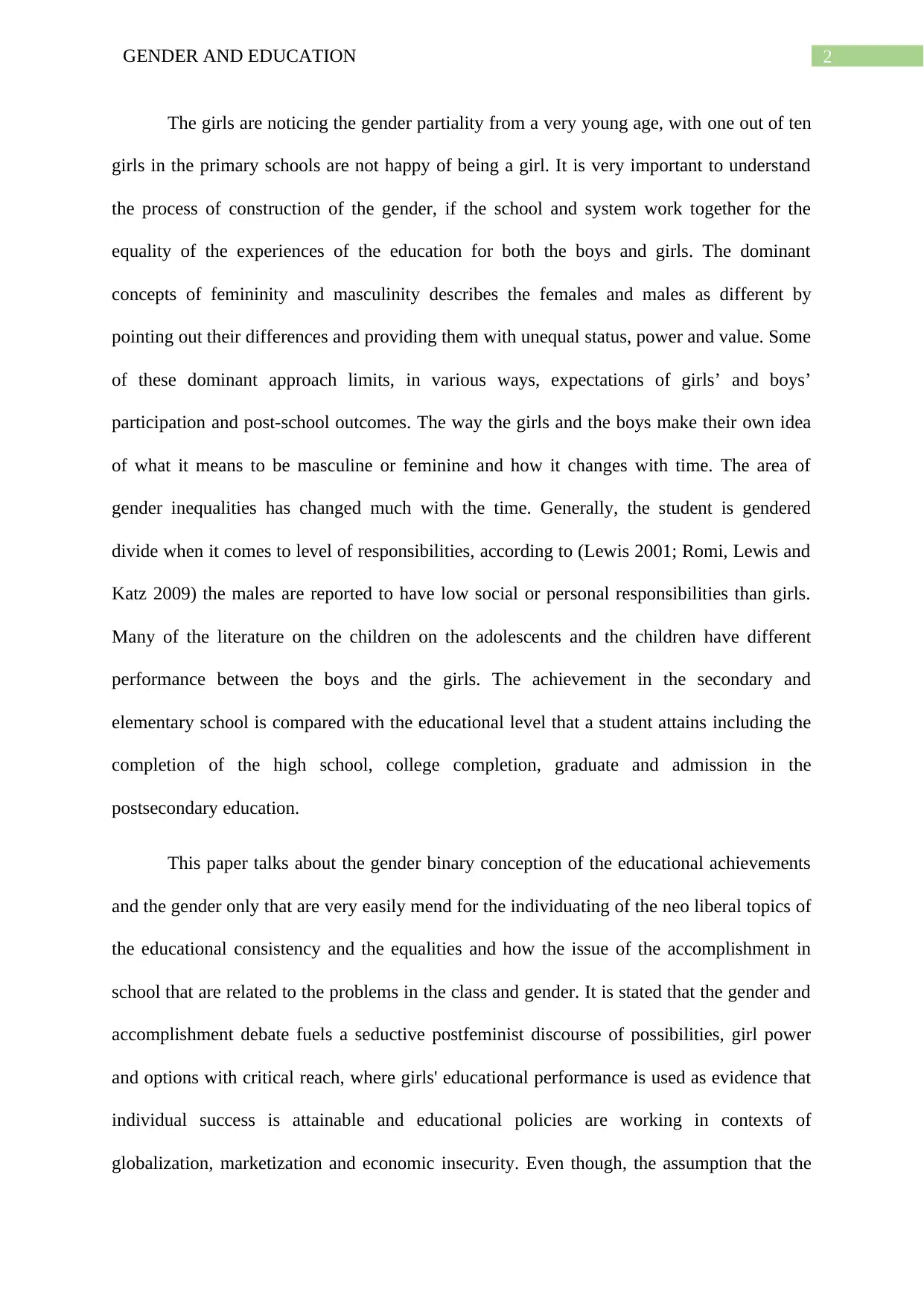
2GENDER AND EDUCATION
The girls are noticing the gender partiality from a very young age, with one out of ten
girls in the primary schools are not happy of being a girl. It is very important to understand
the process of construction of the gender, if the school and system work together for the
equality of the experiences of the education for both the boys and girls. The dominant
concepts of femininity and masculinity describes the females and males as different by
pointing out their differences and providing them with unequal status, power and value. Some
of these dominant approach limits, in various ways, expectations of girls’ and boys’
participation and post-school outcomes. The way the girls and the boys make their own idea
of what it means to be masculine or feminine and how it changes with time. The area of
gender inequalities has changed much with the time. Generally, the student is gendered
divide when it comes to level of responsibilities, according to (Lewis 2001; Romi, Lewis and
Katz 2009) the males are reported to have low social or personal responsibilities than girls.
Many of the literature on the children on the adolescents and the children have different
performance between the boys and the girls. The achievement in the secondary and
elementary school is compared with the educational level that a student attains including the
completion of the high school, college completion, graduate and admission in the
postsecondary education.
This paper talks about the gender binary conception of the educational achievements
and the gender only that are very easily mend for the individuating of the neo liberal topics of
the educational consistency and the equalities and how the issue of the accomplishment in
school that are related to the problems in the class and gender. It is stated that the gender and
accomplishment debate fuels a seductive postfeminist discourse of possibilities, girl power
and options with critical reach, where girls' educational performance is used as evidence that
individual success is attainable and educational policies are working in contexts of
globalization, marketization and economic insecurity. Even though, the assumption that the
The girls are noticing the gender partiality from a very young age, with one out of ten
girls in the primary schools are not happy of being a girl. It is very important to understand
the process of construction of the gender, if the school and system work together for the
equality of the experiences of the education for both the boys and girls. The dominant
concepts of femininity and masculinity describes the females and males as different by
pointing out their differences and providing them with unequal status, power and value. Some
of these dominant approach limits, in various ways, expectations of girls’ and boys’
participation and post-school outcomes. The way the girls and the boys make their own idea
of what it means to be masculine or feminine and how it changes with time. The area of
gender inequalities has changed much with the time. Generally, the student is gendered
divide when it comes to level of responsibilities, according to (Lewis 2001; Romi, Lewis and
Katz 2009) the males are reported to have low social or personal responsibilities than girls.
Many of the literature on the children on the adolescents and the children have different
performance between the boys and the girls. The achievement in the secondary and
elementary school is compared with the educational level that a student attains including the
completion of the high school, college completion, graduate and admission in the
postsecondary education.
This paper talks about the gender binary conception of the educational achievements
and the gender only that are very easily mend for the individuating of the neo liberal topics of
the educational consistency and the equalities and how the issue of the accomplishment in
school that are related to the problems in the class and gender. It is stated that the gender and
accomplishment debate fuels a seductive postfeminist discourse of possibilities, girl power
and options with critical reach, where girls' educational performance is used as evidence that
individual success is attainable and educational policies are working in contexts of
globalization, marketization and economic insecurity. Even though, the assumption that the
⊘ This is a preview!⊘
Do you want full access?
Subscribe today to unlock all pages.

Trusted by 1+ million students worldwide
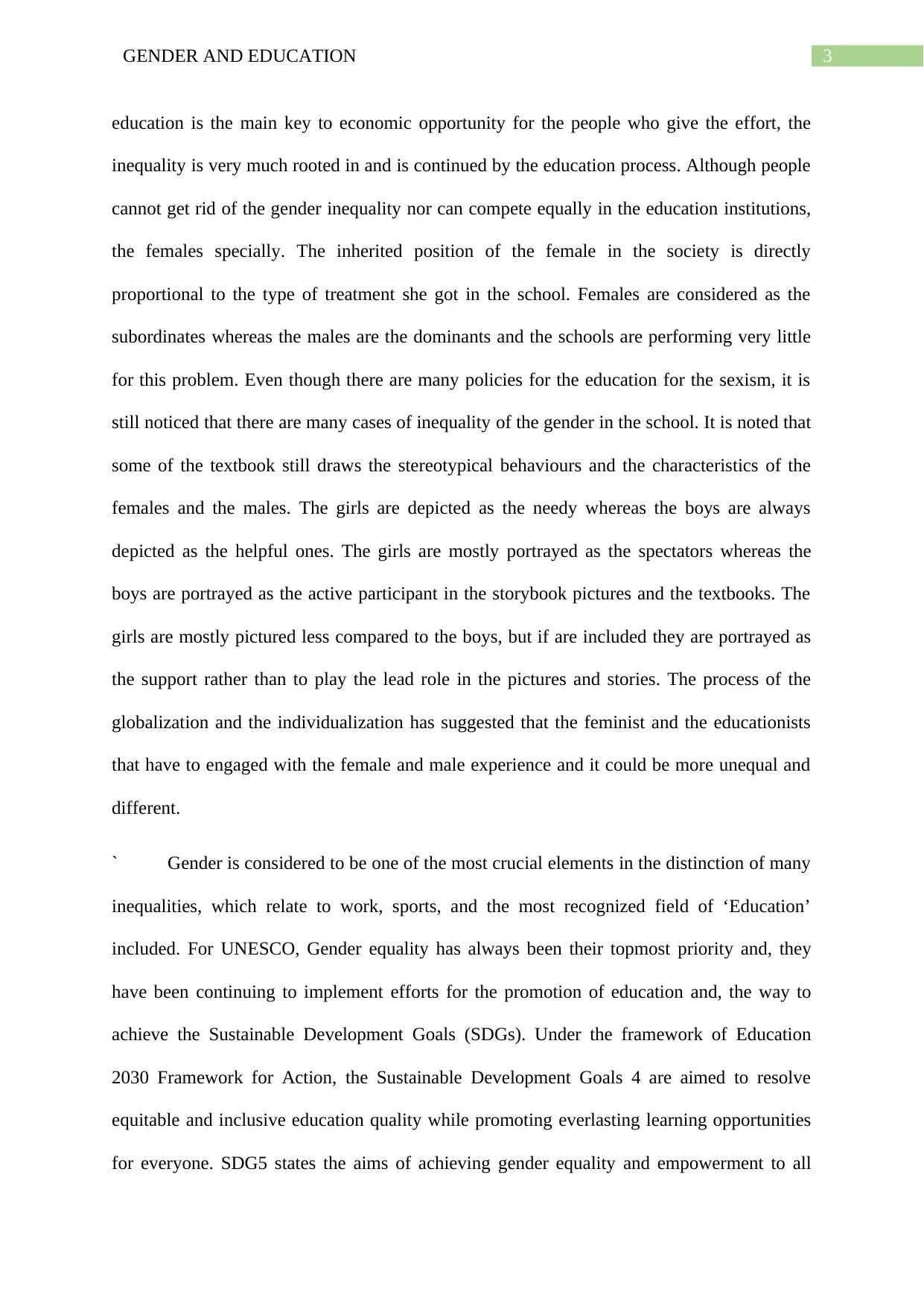
3GENDER AND EDUCATION
education is the main key to economic opportunity for the people who give the effort, the
inequality is very much rooted in and is continued by the education process. Although people
cannot get rid of the gender inequality nor can compete equally in the education institutions,
the females specially. The inherited position of the female in the society is directly
proportional to the type of treatment she got in the school. Females are considered as the
subordinates whereas the males are the dominants and the schools are performing very little
for this problem. Even though there are many policies for the education for the sexism, it is
still noticed that there are many cases of inequality of the gender in the school. It is noted that
some of the textbook still draws the stereotypical behaviours and the characteristics of the
females and the males. The girls are depicted as the needy whereas the boys are always
depicted as the helpful ones. The girls are mostly portrayed as the spectators whereas the
boys are portrayed as the active participant in the storybook pictures and the textbooks. The
girls are mostly pictured less compared to the boys, but if are included they are portrayed as
the support rather than to play the lead role in the pictures and stories. The process of the
globalization and the individualization has suggested that the feminist and the educationists
that have to engaged with the female and male experience and it could be more unequal and
different.
` Gender is considered to be one of the most crucial elements in the distinction of many
inequalities, which relate to work, sports, and the most recognized field of ‘Education’
included. For UNESCO, Gender equality has always been their topmost priority and, they
have been continuing to implement efforts for the promotion of education and, the way to
achieve the Sustainable Development Goals (SDGs). Under the framework of Education
2030 Framework for Action, the Sustainable Development Goals 4 are aimed to resolve
equitable and inclusive education quality while promoting everlasting learning opportunities
for everyone. SDG5 states the aims of achieving gender equality and empowerment to all
education is the main key to economic opportunity for the people who give the effort, the
inequality is very much rooted in and is continued by the education process. Although people
cannot get rid of the gender inequality nor can compete equally in the education institutions,
the females specially. The inherited position of the female in the society is directly
proportional to the type of treatment she got in the school. Females are considered as the
subordinates whereas the males are the dominants and the schools are performing very little
for this problem. Even though there are many policies for the education for the sexism, it is
still noticed that there are many cases of inequality of the gender in the school. It is noted that
some of the textbook still draws the stereotypical behaviours and the characteristics of the
females and the males. The girls are depicted as the needy whereas the boys are always
depicted as the helpful ones. The girls are mostly portrayed as the spectators whereas the
boys are portrayed as the active participant in the storybook pictures and the textbooks. The
girls are mostly pictured less compared to the boys, but if are included they are portrayed as
the support rather than to play the lead role in the pictures and stories. The process of the
globalization and the individualization has suggested that the feminist and the educationists
that have to engaged with the female and male experience and it could be more unequal and
different.
` Gender is considered to be one of the most crucial elements in the distinction of many
inequalities, which relate to work, sports, and the most recognized field of ‘Education’
included. For UNESCO, Gender equality has always been their topmost priority and, they
have been continuing to implement efforts for the promotion of education and, the way to
achieve the Sustainable Development Goals (SDGs). Under the framework of Education
2030 Framework for Action, the Sustainable Development Goals 4 are aimed to resolve
equitable and inclusive education quality while promoting everlasting learning opportunities
for everyone. SDG5 states the aims of achieving gender equality and empowerment to all
Paraphrase This Document
Need a fresh take? Get an instant paraphrase of this document with our AI Paraphraser
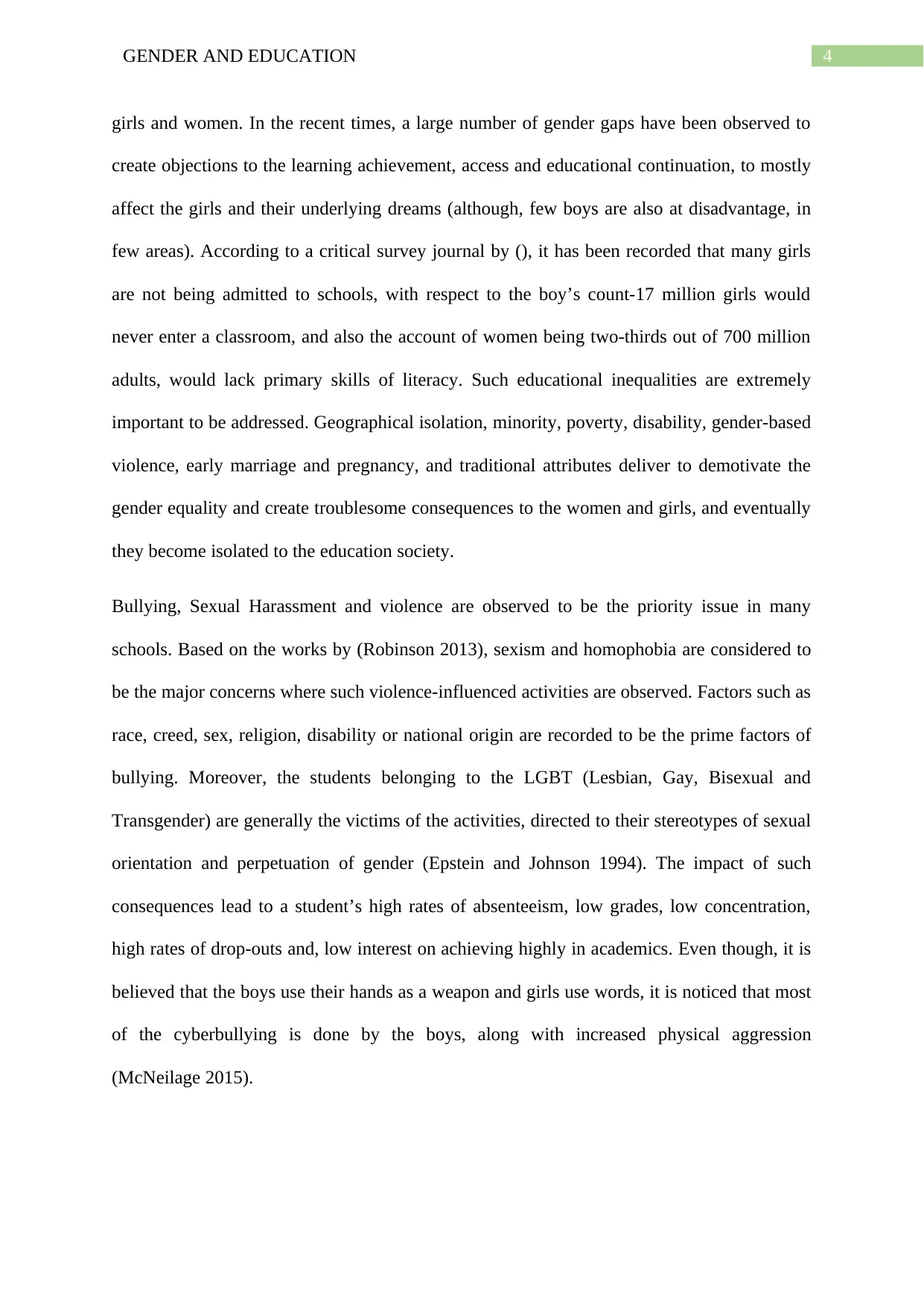
4GENDER AND EDUCATION
girls and women. In the recent times, a large number of gender gaps have been observed to
create objections to the learning achievement, access and educational continuation, to mostly
affect the girls and their underlying dreams (although, few boys are also at disadvantage, in
few areas). According to a critical survey journal by (), it has been recorded that many girls
are not being admitted to schools, with respect to the boy’s count-17 million girls would
never enter a classroom, and also the account of women being two-thirds out of 700 million
adults, would lack primary skills of literacy. Such educational inequalities are extremely
important to be addressed. Geographical isolation, minority, poverty, disability, gender-based
violence, early marriage and pregnancy, and traditional attributes deliver to demotivate the
gender equality and create troublesome consequences to the women and girls, and eventually
they become isolated to the education society.
Bullying, Sexual Harassment and violence are observed to be the priority issue in many
schools. Based on the works by (Robinson 2013), sexism and homophobia are considered to
be the major concerns where such violence-influenced activities are observed. Factors such as
race, creed, sex, religion, disability or national origin are recorded to be the prime factors of
bullying. Moreover, the students belonging to the LGBT (Lesbian, Gay, Bisexual and
Transgender) are generally the victims of the activities, directed to their stereotypes of sexual
orientation and perpetuation of gender (Epstein and Johnson 1994). The impact of such
consequences lead to a student’s high rates of absenteeism, low grades, low concentration,
high rates of drop-outs and, low interest on achieving highly in academics. Even though, it is
believed that the boys use their hands as a weapon and girls use words, it is noticed that most
of the cyberbullying is done by the boys, along with increased physical aggression
(McNeilage 2015).
girls and women. In the recent times, a large number of gender gaps have been observed to
create objections to the learning achievement, access and educational continuation, to mostly
affect the girls and their underlying dreams (although, few boys are also at disadvantage, in
few areas). According to a critical survey journal by (), it has been recorded that many girls
are not being admitted to schools, with respect to the boy’s count-17 million girls would
never enter a classroom, and also the account of women being two-thirds out of 700 million
adults, would lack primary skills of literacy. Such educational inequalities are extremely
important to be addressed. Geographical isolation, minority, poverty, disability, gender-based
violence, early marriage and pregnancy, and traditional attributes deliver to demotivate the
gender equality and create troublesome consequences to the women and girls, and eventually
they become isolated to the education society.
Bullying, Sexual Harassment and violence are observed to be the priority issue in many
schools. Based on the works by (Robinson 2013), sexism and homophobia are considered to
be the major concerns where such violence-influenced activities are observed. Factors such as
race, creed, sex, religion, disability or national origin are recorded to be the prime factors of
bullying. Moreover, the students belonging to the LGBT (Lesbian, Gay, Bisexual and
Transgender) are generally the victims of the activities, directed to their stereotypes of sexual
orientation and perpetuation of gender (Epstein and Johnson 1994). The impact of such
consequences lead to a student’s high rates of absenteeism, low grades, low concentration,
high rates of drop-outs and, low interest on achieving highly in academics. Even though, it is
believed that the boys use their hands as a weapon and girls use words, it is noticed that most
of the cyberbullying is done by the boys, along with increased physical aggression
(McNeilage 2015).
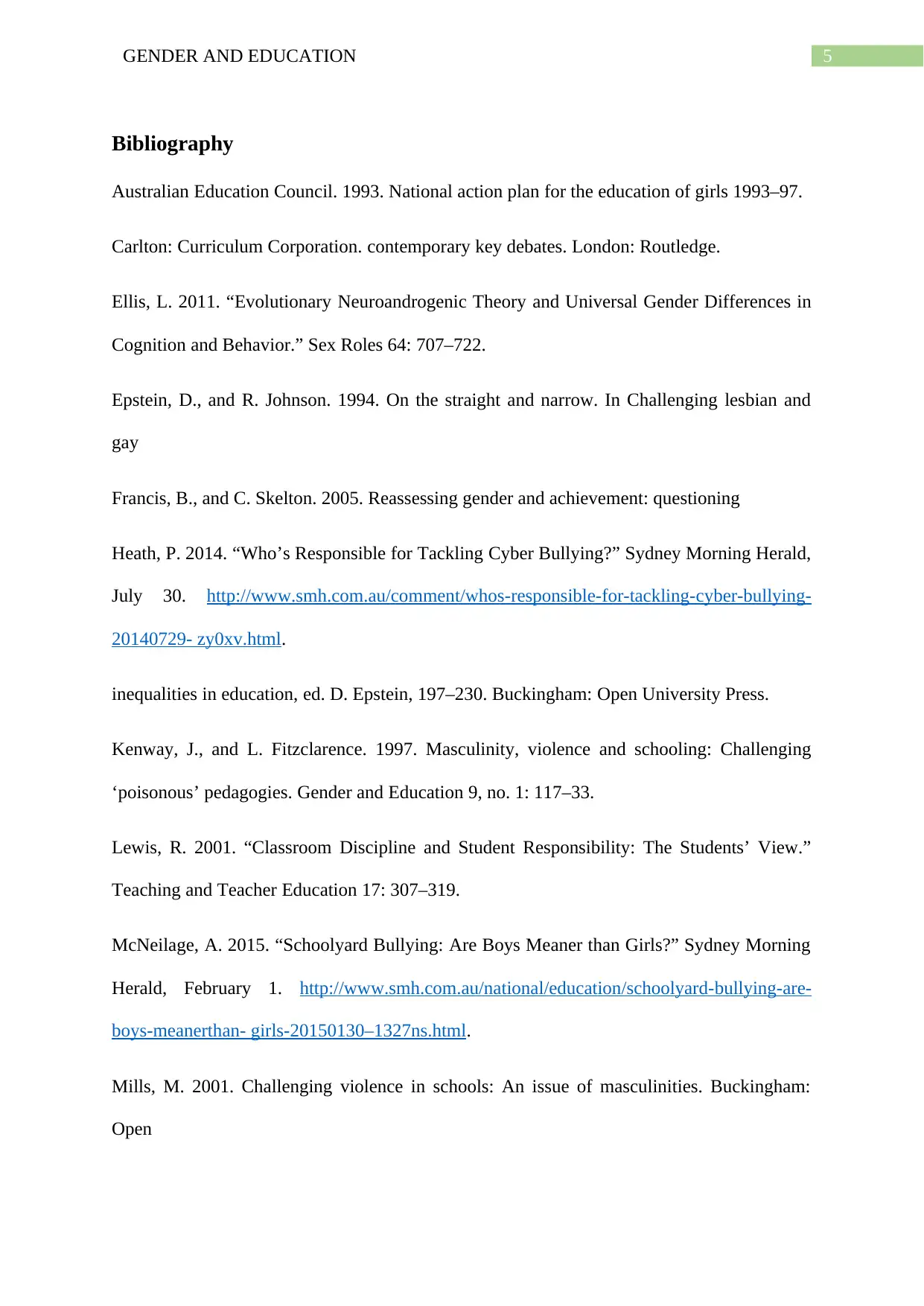
5GENDER AND EDUCATION
Bibliography
Australian Education Council. 1993. National action plan for the education of girls 1993–97.
Carlton: Curriculum Corporation. contemporary key debates. London: Routledge.
Ellis, L. 2011. “Evolutionary Neuroandrogenic Theory and Universal Gender Differences in
Cognition and Behavior.” Sex Roles 64: 707–722.
Epstein, D., and R. Johnson. 1994. On the straight and narrow. In Challenging lesbian and
gay
Francis, B., and C. Skelton. 2005. Reassessing gender and achievement: questioning
Heath, P. 2014. “Who’s Responsible for Tackling Cyber Bullying?” Sydney Morning Herald,
July 30. http://www.smh.com.au/comment/whos-responsible-for-tackling-cyber-bullying-
20140729- zy0xv.html.
inequalities in education, ed. D. Epstein, 197–230. Buckingham: Open University Press.
Kenway, J., and L. Fitzclarence. 1997. Masculinity, violence and schooling: Challenging
‘poisonous’ pedagogies. Gender and Education 9, no. 1: 117–33.
Lewis, R. 2001. “Classroom Discipline and Student Responsibility: The Students’ View.”
Teaching and Teacher Education 17: 307–319.
McNeilage, A. 2015. “Schoolyard Bullying: Are Boys Meaner than Girls?” Sydney Morning
Herald, February 1. http://www.smh.com.au/national/education/schoolyard-bullying-are-
boys-meanerthan- girls-20150130–1327ns.html.
Mills, M. 2001. Challenging violence in schools: An issue of masculinities. Buckingham:
Open
Bibliography
Australian Education Council. 1993. National action plan for the education of girls 1993–97.
Carlton: Curriculum Corporation. contemporary key debates. London: Routledge.
Ellis, L. 2011. “Evolutionary Neuroandrogenic Theory and Universal Gender Differences in
Cognition and Behavior.” Sex Roles 64: 707–722.
Epstein, D., and R. Johnson. 1994. On the straight and narrow. In Challenging lesbian and
gay
Francis, B., and C. Skelton. 2005. Reassessing gender and achievement: questioning
Heath, P. 2014. “Who’s Responsible for Tackling Cyber Bullying?” Sydney Morning Herald,
July 30. http://www.smh.com.au/comment/whos-responsible-for-tackling-cyber-bullying-
20140729- zy0xv.html.
inequalities in education, ed. D. Epstein, 197–230. Buckingham: Open University Press.
Kenway, J., and L. Fitzclarence. 1997. Masculinity, violence and schooling: Challenging
‘poisonous’ pedagogies. Gender and Education 9, no. 1: 117–33.
Lewis, R. 2001. “Classroom Discipline and Student Responsibility: The Students’ View.”
Teaching and Teacher Education 17: 307–319.
McNeilage, A. 2015. “Schoolyard Bullying: Are Boys Meaner than Girls?” Sydney Morning
Herald, February 1. http://www.smh.com.au/national/education/schoolyard-bullying-are-
boys-meanerthan- girls-20150130–1327ns.html.
Mills, M. 2001. Challenging violence in schools: An issue of masculinities. Buckingham:
Open
⊘ This is a preview!⊘
Do you want full access?
Subscribe today to unlock all pages.

Trusted by 1+ million students worldwide
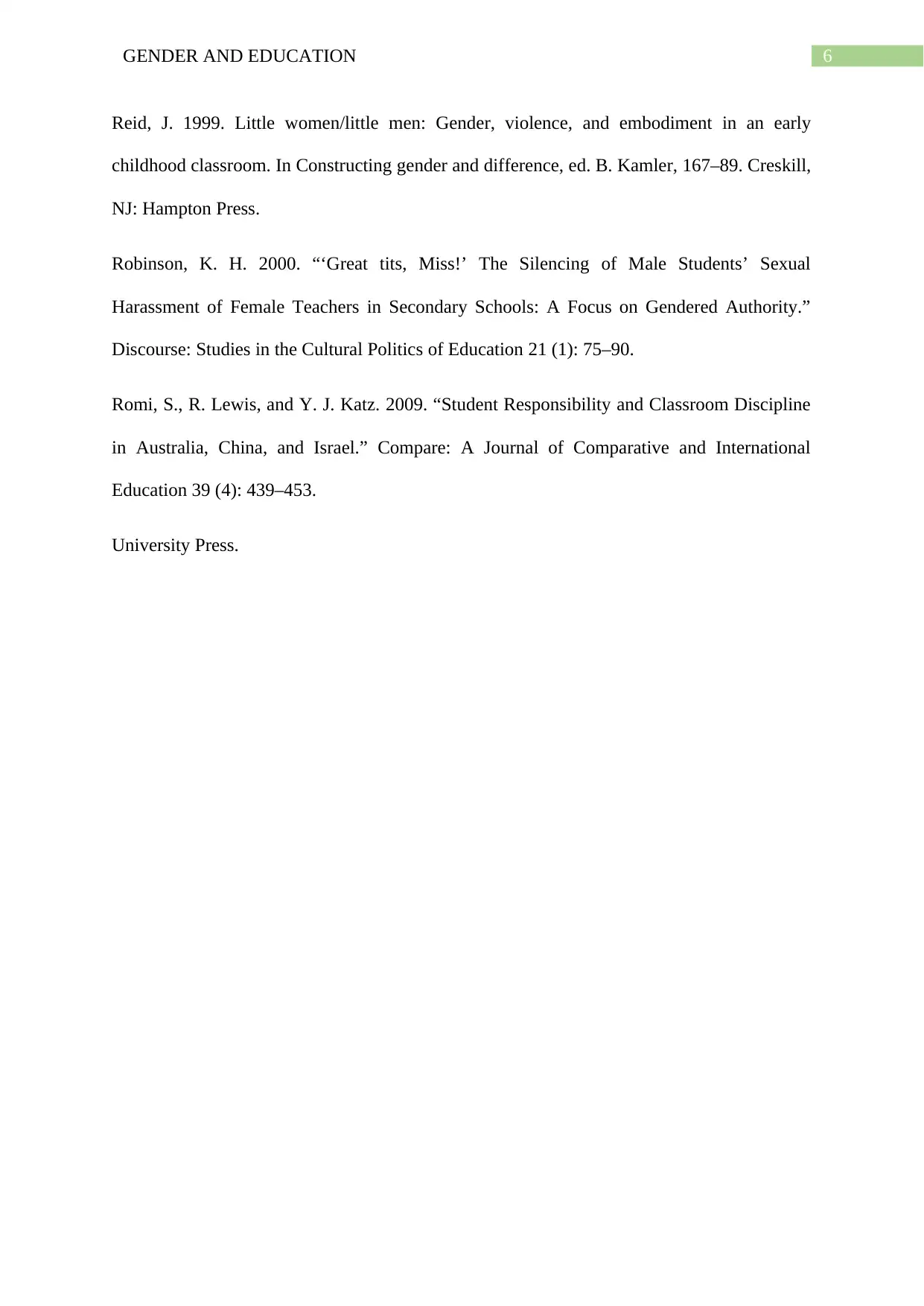
6GENDER AND EDUCATION
Reid, J. 1999. Little women/little men: Gender, violence, and embodiment in an early
childhood classroom. In Constructing gender and difference, ed. B. Kamler, 167–89. Creskill,
NJ: Hampton Press.
Robinson, K. H. 2000. “‘Great tits, Miss!’ The Silencing of Male Students’ Sexual
Harassment of Female Teachers in Secondary Schools: A Focus on Gendered Authority.”
Discourse: Studies in the Cultural Politics of Education 21 (1): 75–90.
Romi, S., R. Lewis, and Y. J. Katz. 2009. “Student Responsibility and Classroom Discipline
in Australia, China, and Israel.” Compare: A Journal of Comparative and International
Education 39 (4): 439–453.
University Press.
Reid, J. 1999. Little women/little men: Gender, violence, and embodiment in an early
childhood classroom. In Constructing gender and difference, ed. B. Kamler, 167–89. Creskill,
NJ: Hampton Press.
Robinson, K. H. 2000. “‘Great tits, Miss!’ The Silencing of Male Students’ Sexual
Harassment of Female Teachers in Secondary Schools: A Focus on Gendered Authority.”
Discourse: Studies in the Cultural Politics of Education 21 (1): 75–90.
Romi, S., R. Lewis, and Y. J. Katz. 2009. “Student Responsibility and Classroom Discipline
in Australia, China, and Israel.” Compare: A Journal of Comparative and International
Education 39 (4): 439–453.
University Press.
1 out of 7
Related Documents
Your All-in-One AI-Powered Toolkit for Academic Success.
+13062052269
info@desklib.com
Available 24*7 on WhatsApp / Email
![[object Object]](/_next/static/media/star-bottom.7253800d.svg)
Unlock your academic potential
Copyright © 2020–2026 A2Z Services. All Rights Reserved. Developed and managed by ZUCOL.





